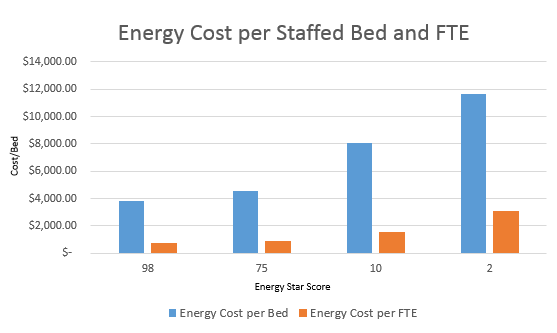Translating the Cost of Energy Reduction
Tip #2
Translating the Cost of Energy Reduction
By Kara Brooks, LEED AP BD & C, ASHE Sustainability Program Manager
Health care facility professionals are often looking for ways to get the attention and support of the C-Suite for energy reducing strategies. Discussing energy savings on a square foot basis may not always get the attention desired. The EPA’s Energy Star Portfolio Manager has broken down the data for facilities in Energy Star’s Portfolio Manager in a guide, “Energy Use in Hospitals,”which helps establish the results of a facility’s efforts toward energy reduction. This is a great guide for those who want to understand the implications of energy reduction through a variety of metrics—not just those based on square footage. To illustrate how these other metrics can be used, let’s take a look at a per-bed metric for four sample health care facilities.
A per-bed metric examines the affect that energy has per bed, not per square foot. In its “Energy Use in Hospitals” guide, the EPA states that the median beds per square foot is around 0.5 beds/1,000 square feet. This number is important as it can be used to determine the cost of energy on a per bed basis.
Similarly, the EPA states that the median number of FTEs per square foot is 2.6 FTEs/1,000 square feet. Again, we can use this number to understand the effect of energy use as it relates to number of FTEs. From there we can further understand how improving a facility’s ENERGY STAR score can help establish a business case for saving energy. The following graph depicts each of these metrics as they are compared to ENERGY STAR scores for four sample healthcare facilities with an estimated median range of staffed beds between 110 and 190:

It’s easy to see that the cost of energy drops dramatically on both a staffed bed and FTE basis as the ENERGY STAR score rises.
Why is this important to the C-Suite? The data show that even small energy reductions can make a big difference. the hospital with the ENERGY STAR score of 2, the cost per bed is about $11,700 with a cost per FTE of around $3,000. For the hospital with an Energy Star Score of 10—a relatively modest improvement—the cost per bed is $8,050 with a cost per FTE of around $1,550.
By making small changes, facilities can re-allocate their resources, allowing for additional FTEs or projects that improve patient care. Communicating the benefits of energy efficiency in this way makes a complex concept easy to understand for those who manage beds or staffing.
